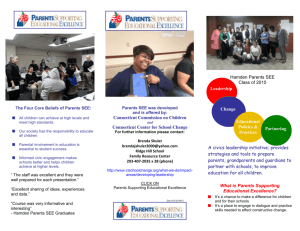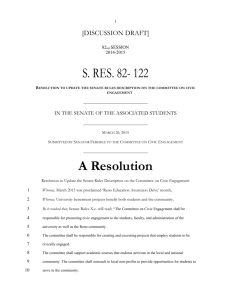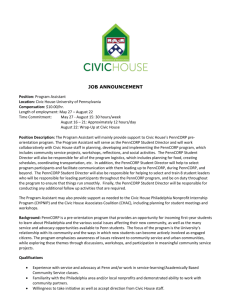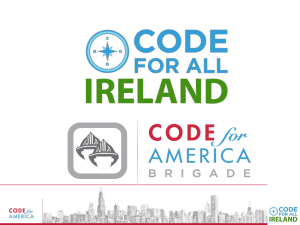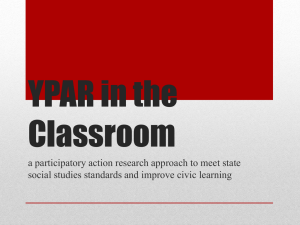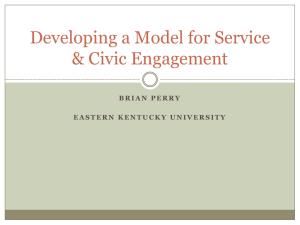2011 Strategic Plan - Department of – Communication
advertisement
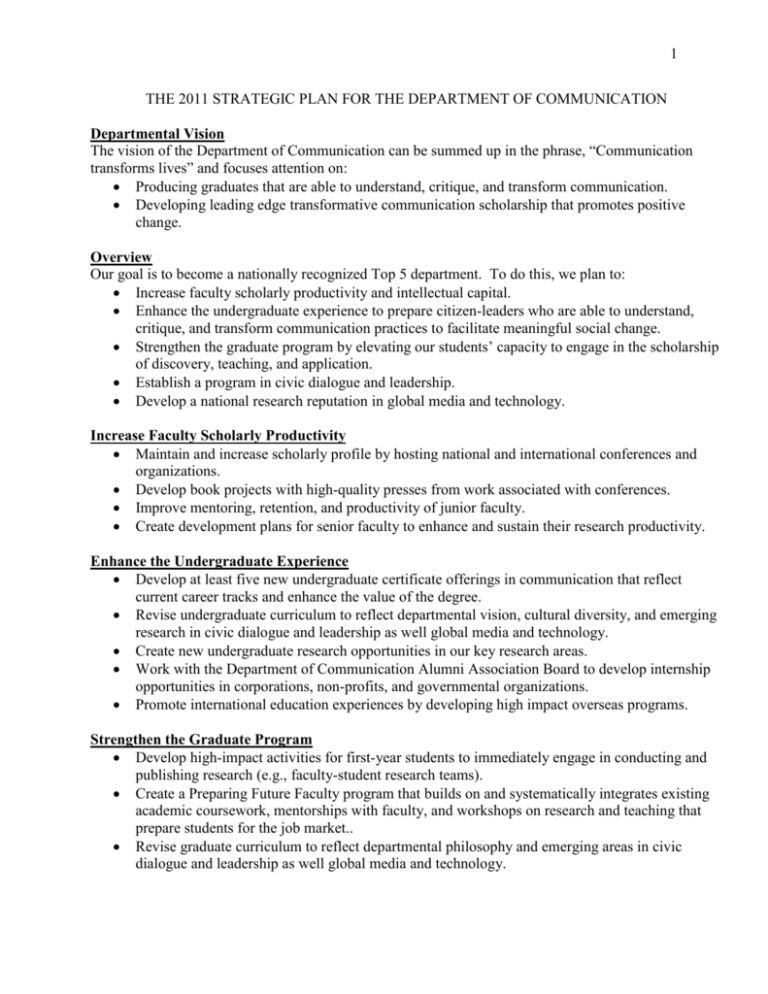
1 THE 2011 STRATEGIC PLAN FOR THE DEPARTMENT OF COMMUNICATION Departmental Vision The vision of the Department of Communication can be summed up in the phrase, “Communication transforms lives” and focuses attention on: Producing graduates that are able to understand, critique, and transform communication. Developing leading edge transformative communication scholarship that promotes positive change. Overview Our goal is to become a nationally recognized Top 5 department. To do this, we plan to: Increase faculty scholarly productivity and intellectual capital. Enhance the undergraduate experience to prepare citizen-leaders who are able to understand, critique, and transform communication practices to facilitate meaningful social change. Strengthen the graduate program by elevating our students’ capacity to engage in the scholarship of discovery, teaching, and application. Establish a program in civic dialogue and leadership. Develop a national research reputation in global media and technology. Increase Faculty Scholarly Productivity Maintain and increase scholarly profile by hosting national and international conferences and organizations. Develop book projects with high-quality presses from work associated with conferences. Improve mentoring, retention, and productivity of junior faculty. Create development plans for senior faculty to enhance and sustain their research productivity. Enhance the Undergraduate Experience Develop at least five new undergraduate certificate offerings in communication that reflect current career tracks and enhance the value of the degree. Revise undergraduate curriculum to reflect departmental vision, cultural diversity, and emerging research in civic dialogue and leadership as well global media and technology. Create new undergraduate research opportunities in our key research areas. Work with the Department of Communication Alumni Association Board to develop internship opportunities in corporations, non-profits, and governmental organizations. Promote international education experiences by developing high impact overseas programs. Strengthen the Graduate Program Develop high-impact activities for first-year students to immediately engage in conducting and publishing research (e.g., faculty-student research teams). Create a Preparing Future Faculty program that builds on and systematically integrates existing academic coursework, mentorships with faculty, and workshops on research and teaching that prepare students for the job market.. Revise graduate curriculum to reflect departmental philosophy and emerging areas in civic dialogue and leadership as well global media and technology. 2 Establish a Civic Dialogue and Leadership Program Our goal is to create a Civic Dialogue and Leadership Program (CDLP) as a vehicle for bringing together scholars interested in teaching and researching deliberative forms of communication. We are interested in promoting engagement and conversation regarding new forms of political discourse, active citizenship, and collaborative decision-making processes. Our scholarly approach is distinct among national and Texas institutions of higher education as it incorporates humanities and social science research regarding civic dialogue and leadership. Our approach is also unique as it integrates rhetorical studies and organizational communication in an effort to study issues of civic leadership, the analysis of political issues and processes, and community outreach in the form of citizen training in communication concepts and practices for deliberation. Comparisons with Existing Programs Since civic dialogue and leadership research, pedagogy, and outreach tend to be located within centers and institutes, we compare the proposed CDLP with Texas, national, and aspirational centers. Texas Centers University of Texas, The Annette Strauss Institute for Civic Participation. This Institute focuses on civic participation (e.g., voting) whereas we focus on civic dialogue and leadership in both organizational and political settings. It is an active center and an aspirational program. University of Houston-Downtown, Center for Public Deliberation. The center focuses on training students and communities in facilitation skills. The center is not research oriented. Center for Applied Leadership, Texas A&M University Commerce. The center appears to be a speaker’s bureau rather than a research Center. National Peer Centers University of Washington Center for Communication and Civic Engagement. This center focuses on relationship between public deliberation and digital media technologies but ignores rhetorical studies of public deliberations and the role of organizations in the public sphere. University of Maryland Center for Political Communication and Civic Leadership. This center has databases for scholarly inquiry and conducts town hall meetings. It has not undertaken research on political communication or on the role or organizations in the public sphere. University of Colorado Center for the Study of Conflict, Collaboration, and Creative Governance (3CG). The 3CG examines governance issues and hosts a number of colloquia, public talks, and conferences. Aspirational Centers Penn State, Center for Democratic Deliberation (CDD). The CDD center explores the role of rhetoric and new media in democratic deliberation and is developing civic pedagogy centered on areas of public speaking, argument and debate, rhetorical criticism, and critical thinking. The University of Pennsylvania. Annenberg Public Policy Center. This is the “gold standard” of centers as it integrates rhetorical and social science approaches to develop interventions within communities regarding policy issues regarding political communication, information and society, media and children, health communication, and adolescent communication. 3 University of Virginia, Center for Politics. This center focuses on public policy, government, and civic education programs. It supports social science studies of political communication and not rhetorical studies of public deliberation or the role of organizations in the public sphere. Links to TAMU Departments and Programs Potential partners in the study and teaching of civil dialogue and leadership include the departments of English, Political Science, Sociology, and Performances Studies as well the Office of the Vice President and Associate Provost for Diversity and The Bush School of Government and Service. Current Strengths and Projects A leader in sponsoring nationally known conferences on rhetoric, leadership, and the public sphere. This conference has generated 11 books published by TAMU Press. Strong existing undergraduate curriculum offering coursework on communication and activism, group collaboration, and the role of organizations in society. Pilot project on civil dialogue has been completed in COMM 203, a core curriculum course. Currently ranked 6th (Rhetoric & Public Affairs) and 5th (Organizational) by the CIOS (Communication Institute for Online Scholarship). Outstanding publication records among senior faculty as well as a commitment to public scholarship in the form of blog posts, interviews, editorials, and engaged scholarship. Award winning faculty (NCA Distinguished Scholar, NCA Diamond Anniversary Book Award, NCA Nichols Award, NCA Donald Ecroyd Mentoring Award Significant prospects for furthering research and pedagogical partnerships locally (e.g., Bryan Dispute Resolution Center) and Texas (e.g., Texas Mediation Association). Action Steps Host 2012 conference on symbolic violence and continue biannual conference schedule. Establish a book series on civic dialogue and leadership with a high-quality press such as TAMU press, develop a white paper series, and/or create special issues within national journals. For the presidential election in fall 2012, we will undertake Project 2012, an integrated series of undergraduate/graduate courses and public forums on the connections among civic dialogue, presidential leadership, and citizenship. Secure grants and funding appropriate for CDLP’s activities. Establish undergraduate and graduate certificates in Civic Dialogue and Leadership. Establish CDLP website, quarterly open public forums on civic dialogue and leadership, and establish CLCD podcast series. Explore a partnership with the TAMU Speech & Debate Team. Develop facilitation training material for training TAMU students and community members. Create a Research Focus in Global Media and Technology Global Media and Information Technology have become a predominant factor in politics, economic development, work life, and personal communication. Within the discipline, one of the fastest growing areas is in new media technologies. Our goal is to develop a strong national and international identity in global media and information technology, and to develop students and researchers who can contribute across a host of institutions and professions, including the media industries, governments, business and trade, and scientific and academic professions, that rely on these global media and technology networks. 4 Comparisons with Existing Programs Our distinctive approach places complementary emphases on traditional media, new media (e.g, cable and satellite, internet, mobile telephony, social media), and technology applications in specific social contexts (politics and geopolitics, religion, governance, migration, identity formation, community, education, journalism, ICT4D). Texas Centers University of Texas. Has developed research clusters within the College of Communication focused on global media, new media and society, and technology and ICT policy. These programs have international reputations, but we differ in that our proposal represents a specific fusion of global media and new media, to develop new research areas. National/International Peer and Aspirational Centers Oxford Internet Institute. The Institute was founded as a department of the University of Oxford in 2001, as an academic center for the study of the societal implications of the Internet. The Institute has established an international reputation for internet studies (or new media) studies, but without a grounding in global-international media studies. The University of Pennsylvania. Center for Global Media Studies (CGCS). The CGCS is a leader in international education and training in comparative media law and policy, including new media technologies. The center focuses on providing opportunities for students, academics, lawyers, regulators, and civil society representatives to evaluate and discuss comparative, global communications issues. Harvard University, The Berkman Center for Internet and Society. The Berkman Center's mission is to explore and understand cyberspace; to study its development, norms, and standards; and to assess the need for laws and sanctions. Links to TAMU Departments and Programs The new interdisciplinary program in Digital Humanities will support the development of new media studies. Potential TAMU partners are sociology, performance studies, film studies, Bush School (geopolitics of media/new media), Health Science Center (health and technology), and the Colleges of Agriculture (ICT4D), Architecture (visualization), and Geosciences (Geospatial applications research). Significant prospects for intradepartmental research teams in health communication (health care technologies), organizational communication (technology in organizations, globalization in organizations), and civic dialogue and leadership (online community building, new media ‘literacy) Current Strengths and Projects Strong group of younger and mid-level faculty within related and relevant research clusters This proposed research cluster presents significant prospects for cultivating major grants, contracts, donor gifts, and corporate sponsorships o Currently supports the BMS Broadcast Monitoring System (funded by Technology Support Working Group) (Department of Defense). o Media Management Portal (potential, with BBN Raytheon) o Automatic translation/monitoring of multilingual social media 5 Action Steps Develop undergraduate curriculum in international and global communication and new media studies. Create “international/global media” certificate. Enhance targeted undergraduate study abroad programs to create exposure to global media hubs/centers. Establish undergraduate internships in global media/technology corporations. Targeted recruiting of internationally oriented graduate students that can enhance research capacity. Hosting of visiting scholars who can complement existing regional strengths and research areas. Support core faculty, teaching strengths, and research programs in global media/technology. Continue to sponsor high-visibility conferences, symposia, and other public events, especially interdisciplinary (e.g., Scowcroft Institute). Departmental Benchmarks and Metrics CIOS (Communication Institute for Online Scholarship) rankings: CIOS currently identifies Texas A&M’s Department of Communication as a “Top Ten Research Department,” measured by faculty publications in health communication, rhetorical theories, international communication, organizational communication, and communication technologies. Reputational rankings: National Communication Association and NRC rankings will also be used as they become available. Peer and Aspirational Departments: We will benchmark the following activities and compare ourselves to the selected peer and aspirational communication departments: (1) research productivity, (2) grant and external funding, (3) editorial board membership in national and international communication and media journals, and (4) graduate student placement. Civic Dialogue and Deliberation Benchmarks and Metrics Public Deliberation Center Activities: We have benchmarked eight leading centers in the United States as well as two centers associated with Texas universities and have developed a checklist of activities that must be undertaken regarding: (1) scholarship, (2) education, and (3) outreach. This list is available upon request. Expert Panels: The Public Deliberation Center Activities provide a list of what must be done but do not provide a rating of the quality of those activities. We will assemble an expert panel each year of three scholars that conduct work in civic dialogue and leadership to evaluate the quality of our efforts in scholarship, education, and outreach. Disciplinary Ranking: If the CDLP serves as an intellectual hub for communication faculty, particularly those in the rhetoric and organizational communication areas, we would anticipate the scholarly ranking and reputation of faculty in those areas would increase which would be measured by the benchmarks listed for departmental assessment (NRC, NCA, CIOS) Global Media and Technology We will use the same metrics as articulated for departmental assessment. Funding Priority for Targeted Excellence Civil Dialogue and Leadership—Hire a senior scholar in public deliberation, leadership, or political communication. Ideally, this person should be able to design, facilitate, and assess public deliberations and dialogues in addition to conducting research into these processes. Global Media and Information Technology—hire a senior scholar. Funding for hosting national/international conferences, workshops, and colloquia.
